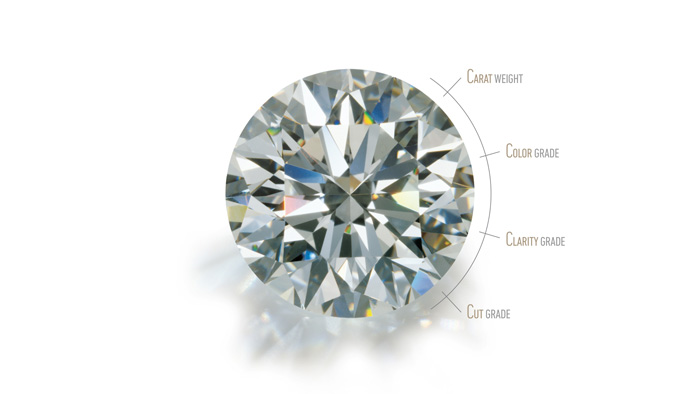Diamond Color In most diamonds, the term actually refers to the absence of color. The less color in the stone, the more desirable and valuable it is. Some of these differences are not visible to the naked eye, but directly impact the overall quality and price of the stone.
Diamond Clarity measures the amount, size and placement of internal ‘inclusions,’ and external ‘blemishes.’ Grades run from ‘Flawless,’ with virtually no imperfections, to ‘Included,’ which contain a significant number of imperfections.
Diamond Cut does not refer to a diamond’s shape, but to the proportion and arrangement of its facets and the quality of workmanship. The amount of brilliance, sparkle and fire in a diamond is determined by cut. Grades range from ‘Excellent’ to ‘Poor.’
Diamond Carat refers to a diamond’s weight. Generally speaking, the higher the carat weight, the more expensive the stone. Two diamonds of equal carat weight, however, can have very different quality and price when the other three Cs are considered.

While many of these are not common in the market, GIA tests every diamond it grades for their presence.
Coating enhances a diamond’s color by masking an undesirable body color with an ultra-thin layer of chemicals or plastics. Another form of coating involves applying a thin film of synthetic diamond to the surface of a diamond simulant, giving it certain characteristics of a real diamond.
HPHT stands for a high-pressure, high-temperature. The process is an effective tool for changing the color of certain diamonds, making them colorless, pink, blue, green, yellowish green, or yellow. Outside of a well-equipped grading laboratory, this form of treatment is virtually undetectable.

While many of these are not common in the market, GIA tests every diamond it grades for their presence.
Coating enhances a diamond’s color by masking an undesirable body color with an ultra-thin layer of chemicals or plastics. Another form of coating involves applying a thin film of synthetic diamond to the surface of a diamond simulant, giving it certain characteristics of a real diamond.
HPHT stands for a high-pressure, high-temperature. The process is an effective tool for changing the color of certain diamonds, making them colorless, pink, blue, green, yellowish green, or yellow. Outside of a well-equipped grading laboratory, this form of treatment is virtually undetectable.
